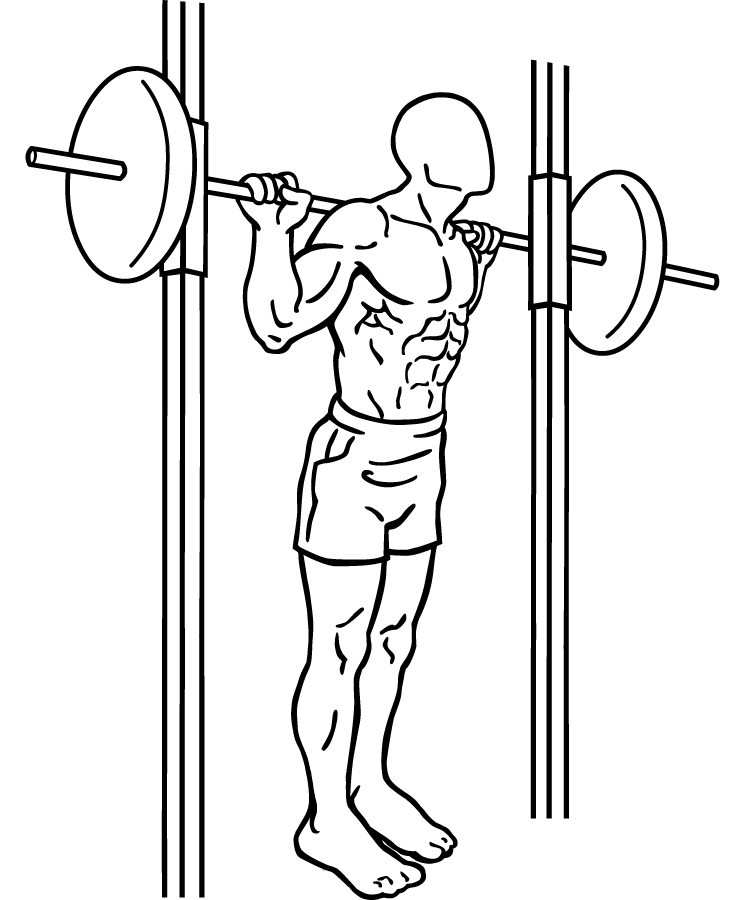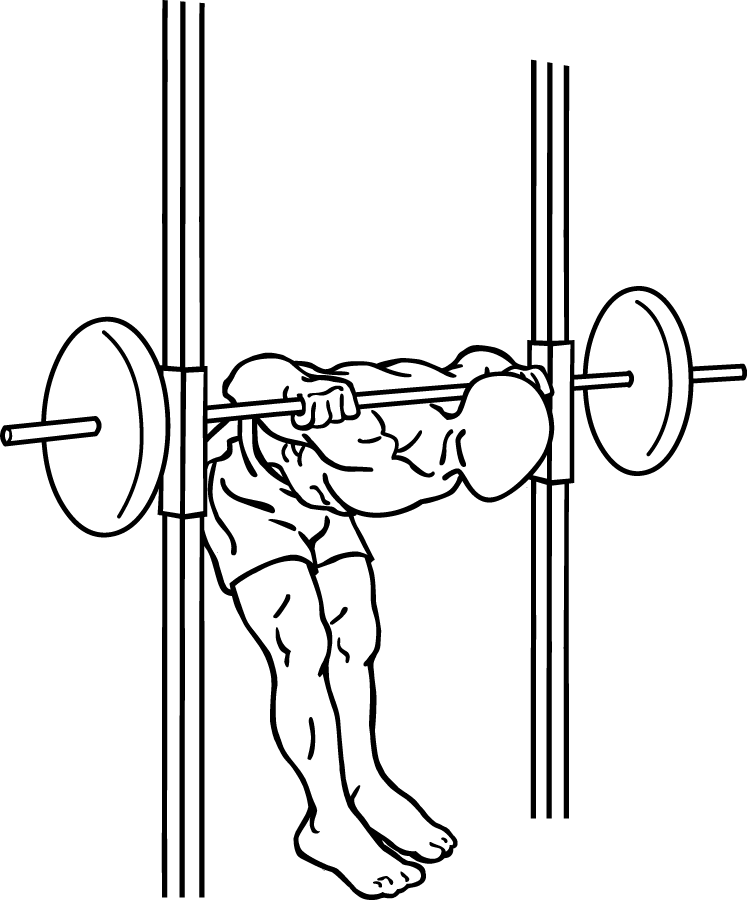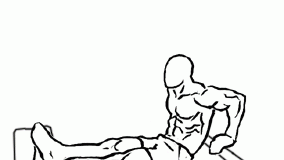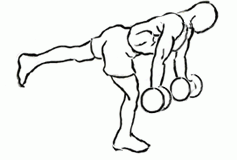Last Updated on September 30, 2022
The Smith Machine Good Mornings exercise is a powerful movement that targets the hamstrings, glutes, and lower back. By using the Smith Machine, you gain more stability than with a free-weight barbell, making it easier to maintain form and focus on working the intended muscles. Good Mornings are an excellent addition to any leg or posterior chain workout, helping build strength, balance, and endurance in the lower body.
In this comprehensive guide, we’ll break down the Smith Machine Good Morning in detail. Learn how to master the form, avoid common mistakes, and use this exercise to improve both strength and muscle tone in your lower body.
1. Exercise Overview: What is the Smith Machine Good Morning?
The Smith Machine Good Mornings is a posterior chain exercise that primarily targets the hamstrings, glutes, and lower back. In this movement, you place a barbell on your upper back and hinge forward at the hips until your upper body is parallel to the floor. The exercise requires a strong core, good balance, and proper technique.
Using the Smith Machine adds stability by guiding the bar’s movement along a fixed path, which can be particularly helpful for beginners or those focusing on form. By controlling the movement, you can isolate the targeted muscles effectively without the risk of the bar drifting forward or backward.
2. Step-by-Step Guide to Performing the Smith Machine Good Mornings
Step 1: Setting Up with the Smith Machine
- Position the bar at shoulder height on the Smith Machine. Set it at a level where you can comfortably place it on your upper back.
- Stand under the bar, positioning it across your shoulders and not on your neck. Place your feet hip-width apart.
Step 2: Grasping the Bar and Positioning Your Feet
- Use a firm grip to stabilize the bar. Your hands should be placed slightly wider than shoulder-width apart.
- Engage your core and ensure your feet are planted firmly on the floor, slightly in front of the bar. This positioning helps with balance and alignment.
Step 3: Hinging at the Hips
- Begin the movement by bending at the hips, pushing your glutes back while keeping your spine straight.
- Keep your head up, chest lifted, and your back neutral. Lower your torso until it’s roughly parallel with the floor.
- Maintain a slight bend in your knees throughout the movement to avoid excessive strain on your lower back.
Step 4: Returning to the Starting Position
- Engage your hamstrings and glutes as you push your hips forward, returning to an upright position.
- Keep the movement slow and controlled, avoiding any sudden jerks that could strain your lower back.
Step 5: Repeating the Movement
- Complete the desired number of reps with this controlled form, focusing on the contraction in your hamstrings and glutes as you return to the top position.
3. Benefits of Smith Machine Good Mornings
The Smith Machine Good Morning provides numerous benefits for strength, flexibility, and stability. Here are some of the main reasons to include this exercise in your routine:
- Strengthens the Posterior Chain: This exercise directly targets the hamstrings, glutes, and lower back, which together make up the posterior chain. Strengthening these muscles improves overall lower body power and stability.
- Improves Hip Mobility: The forward hinge movement encourages greater flexibility in the hip joints, helping to enhance your range of motion and reduce stiffness in the lower back and hips.
- Promotes Core Stability: To maintain balance throughout the movement, your core must be engaged. The Smith Machine provides a more stable environment, allowing you to focus on maintaining a strong core while perfecting your form.
- Reduces Lower Back Strain: By using the Smith Machine, you gain extra stability, which can help reduce the strain on your lower back compared to free-weight Good Mornings. This makes the exercise accessible for those with lower back sensitivity.
- Enhances Athletic Performance: Strong hamstrings and glutes are essential for athletic performance, particularly in sports that involve sprinting, jumping, or explosive movements. The Smith Machine Good Morning supports muscle development to improve performance.
4. Common Mistakes to Avoid
To maximize the benefits of Smith Machine Good Mornings, avoid these common errors:
- Arching or Rounding the Back: Maintaining a neutral spine is crucial for this exercise. Arching or rounding your back can increase the risk of lower back strain or injury. Focus on keeping your chest up and your back straight.
- Bending the Knees Too Much: The Good Morning is a hip-dominant movement, so avoid turning it into a squat by bending your knees too much. Keep your knees soft but don’t allow them to bend excessively, as this shifts the focus away from your hamstrings and glutes.
- Going Too Low: Lowering your torso past parallel can increase strain on the lower back without adding significant benefits. Aim to stop when your upper body is parallel to the floor.
- Using Too Much Weight: Starting with a heavy load can lead to form breakdown. Begin with a lighter weight to ensure you’re comfortable with the movement, and focus on technique before increasing the load.
- Not Engaging the Core: Engaging your core is essential to prevent your back from arching and to maintain balance. Failing to brace your core can increase the risk of losing control over the bar and straining your lower back.
5. Tips to Maximize Results
Here are some expert tips to make the most of your Smith Machine Good Mornings:
- Start with a Warm-Up: Warming up your hips, glutes, and hamstrings with dynamic stretches or light cardio can help prepare your muscles and joints for the exercise.
- Focus on Hip Hinging: Remember that Good Mornings are about hinging at the hips, not squatting down. Imagine pushing your hips back rather than dropping your body down.
- Control the Movement: Keep the movement controlled throughout each rep. Avoid bouncing or using momentum, as this can reduce muscle engagement and increase the risk of strain.
- Breathe Properly: Inhale as you lower your torso and exhale as you return to the starting position. This breathing pattern can help you maintain a strong, stable core and avoid excessive pressure on your lower back.
- Check Your Form Regularly: As you increase the weight, periodically check your form in a mirror or with a trainer to ensure you’re maintaining the correct posture and movement.
6. Variations and Modifications
To keep your routine fresh and target different muscle groups, try these variations of the Smith Machine Good Morning:
- Bodyweight Good Morning: If you’re new to the exercise, start with a bodyweight version. Placing your hands behind your head, practice the hip-hinging movement without added weight. This is a great way to perfect your form.
- Barbell Good Morning: Once you’re comfortable with the Smith Machine version, try using a free barbell. This version requires more balance and core stability, which can help further improve your form and coordination.
- Seated Good Morning: For a different angle, try the seated variation. Sitting on a bench, perform the movement by bending forward from the hips. This focuses more on the lower back, so be cautious with the weight.
- Single-Leg Good Morning: For an added challenge, try a single-leg Good Morning. Perform the movement on one leg to improve balance and focus on each hamstring individually. This variation can be done with or without the Smith Machine.
- Reverse Band Good Morning: Attach resistance bands to the Smith Machine to add variable resistance. This makes the movement more challenging at the top of the range, enhancing muscle engagement.
7. Integrating Smith Machine Good Mornings into Your Workout Routine
Adding Smith Machine Good Mornings to your workout can help improve overall lower body strength. Here’s how to incorporate them effectively:
- Reps and Sets Recommendations: Start with 2-3 sets of 8-12 reps. As you build strength, you can increase the sets or reps for added volume.
- Best Pairings: Pair Smith Machine Good Mornings with other lower body exercises like deadlifts, squats, and lunges. This combination creates a balanced workout that targets multiple muscle groups in the legs and glutes.
- Rest Intervals: Rest for 60-90 seconds between sets to give your muscles enough time to recover. This keeps the workout intense without compromising form.
8. How to Track Progress
Tracking progress in the Smith Machine Good Mornings will help you stay motivated and ensure continued improvement:
- Log Your Weight and Reps: Record the weight used and the number of reps completed for each set. Gradually increase the weight or reps as you feel comfortable to promote strength gains.
- Monitor Range of Motion: Over time, you should be able to lower your torso to a parallel position with better control. Improved range of motion is a sign that your hamstrings and glutes are becoming more flexible and stronger.
- Track Your Form: Check your form periodically to ensure that you’re not rounding your back or bending your knees excessively. Proper form is key to progress in this exercise.
9. Frequently Asked Questions
Q: Can I do Smith Machine Good Mornings if I have lower back issues? A: If you have any back issues, consult a medical professional before attempting this exercise. Starting with bodyweight Good Mornings or a lighter weight can help you understand the movement without straining your lower back.
Q: How heavy should the barbell be for Good Mornings? A: Start with a light weight that allows you to maintain form and control. Once you’re comfortable with the movement, increase the weight gradually. Good Mornings focus on control and form over heavy lifting.
Q: Should I perform Smith Machine Good Mornings quickly or slowly? A: This exercise should be done slowly and with control. Quick movements can lead to using momentum, which reduces effectiveness and increases the risk of injury.
Conclusion
The Smith Machine Good Mornings is a fantastic exercise for building strength in the hamstrings, glutes, and lower back. It’s a staple for anyone looking to develop a strong, balanced posterior chain while improving hip mobility and core stability. With the Smith Machine’s stability, it’s also an excellent choice for those who are new to Good Mornings or are focused on mastering their form.
Remember, form is everything when it comes to the Smith Machine Good Morning. By following the step-by-step guide, avoiding common mistakes, and incorporating variations to keep your routine engaging, you can make steady progress while reducing the risk of injury.
So, add the Smith Machine Good Morning to your next lower body workout and enjoy the benefits of a stronger, more stable core and a powerful posterior chain!








